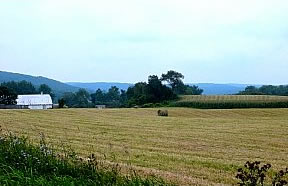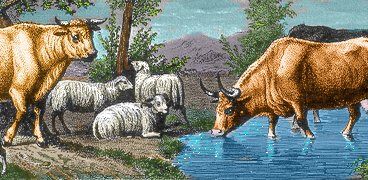
"The village of Oxford, incorporated April 6, 1808, is
located in one of the most charmingly developed farming districts
in Chenango County, and lies in a narrow valley closely hemmed
in by green rounded hills whose contour clearly betrays the
glacial action of past ages. Fields under careful cultivation
and meadows on which graze large herds of cattle, with here
and there a wood lot, make a picture soft in coloring and one
rarely seen."
This description, written in 1906, was in the book, "Annals
of Oxford, NY", by H. J. Galpin. It's as apt a description
of Oxford today as it was nearly a hundred years ago.
People have been farming the land in Oxford for centuries. It's never been easy, with its rocks, short (zone 4) growing season, browsing wildlife, stubborn weeds and pests, and some other annoyances, but people stick with it. Why? Maybe it's the lure of the nutrient rich, fertile soil, possibly natural irrigation from underground springs, and plenty of fresh air and sunshine. In addition, the land may have been in the family, they enjoy making things grow, and/or maybe that's just what they do and love best. Generations of people have stayed here because of its beauty, abundant rain fall, and vast acreage.
The mention of "glacial action of past ages" (in the 1906 passage) refers to the glaciers of the last ice age, some 18,000 years ago. They moved through New York State scraping away top soil and creating valleys. When the ice retreated it deposited hills of gravelly debris. (Today it's fairly common to find sedimentary stones while digging, that will split to reveal fossil remains of shells, where there has been no water for centuries.) It is this legacy of seemingly endless rocks that farmers deal with all the time. It created a job for children or 'idle hands', after plowing the soil, known as "stone picking". Some of these stones have been used to create low fences/walls on the perimeter of the properties. (Just another fine example of Yankee ingenuity). Even with today's modern machinery, these rocks can break blades without mercy. (When backhoes aren't strong enough for big boulders, sometimes explosives have been employed!)
 One of the oldest Oxford farms on record, is Corn Hill Farm.
Benjamin Butler was born in 1764 (and was one of the founders
of St. Paul's Episcopal Church). In 1806, he moved his wife
Hannah and their children (originally from CT) to Oxford, NY.
After several residences, they settled into what became, "Corn
Hill Farm", raising sheep on State Street. Benjamin was
also a successful land broker, but not nearly as successful
as his sheep production. He had so many sheep, that the hills
surrounding Oxford village were covered like a fluffy white
blanket! At the age of 75, in 1839, he passed away, and his
flocks had to be distributed all over the state.
One of the oldest Oxford farms on record, is Corn Hill Farm.
Benjamin Butler was born in 1764 (and was one of the founders
of St. Paul's Episcopal Church). In 1806, he moved his wife
Hannah and their children (originally from CT) to Oxford, NY.
After several residences, they settled into what became, "Corn
Hill Farm", raising sheep on State Street. Benjamin was
also a successful land broker, but not nearly as successful
as his sheep production. He had so many sheep, that the hills
surrounding Oxford village were covered like a fluffy white
blanket! At the age of 75, in 1839, he passed away, and his
flocks had to be distributed all over the state.
Another very old family farm still in operation, is Marshman Farms, having the honored distinction of being named a "Century Farm"! (One of only four in Chenango County.) Jacob and Arvilla Marshman came from Germany and established their Oxford farm in 1856. For six generations, the Marshmans have actively been involved in the operation of the farm, criteria for the "Century Farm" distinction. In the summer of 2004, the Chenango County Historical Society presented a program and exhibit celebrating the long tradition of the family farm, and the Marshman's Century Farm was featured. In September, the CCHS program concluded with Robert Marshman as the key speaker, presenting historic photographs and a display of farm-related items. Over their years of operation, the Marshman farm, Tiger Lily, has developed a fine reputation for Holstein breeding. Robert Marshman currently operates this modern and progressive dairy farm with his sons John and David. Located on County Road 32, it's 3 miles South of Oxford Village, with over 650 animals on site, milking over 350 registered holsteins daily.

